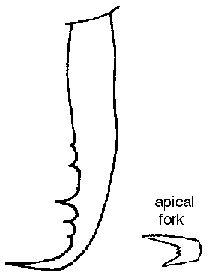
Specimen: Costa Rica, Prov. Heredia: 14km N Volcan Barba, 1220m (J. Longino 1342-s). INBIOCRI001283983. Image by J. Longino.


Specimen: Costa Rica, Prov. Heredia: 14km N Volcan Barba, 1220m (J. Longino 1342-s). INBIOCRI001283983. Image by J. Longino.
This manuscript name is a conditional proposal by B. Bolton (sensu Article 15 of the 1985 ICZN), and thus not made available here. Its appearance here or in any duplication of this page does not constitute publication (sensu Article 8 of the 1985 ICZN).
Dacetonini, Formicidae, Hymenoptera, Insecta, Arthropoda, Animalia
John T. Longino, The Evergreen State College, Olympia WA 98505 USA. longinoj@evergreen.edu
26 July 1997
Specimen: Costa Rica, Prov. Heredia: 14km N Volcan Barba, 1220m (J. Longino 1342-s). INBIOCRI001283983. Image by J. Longino.
|
Specimen: Costa Rica, Prov. Heredia: 14km N Volcan Barba, 1220m (J. Longino 1342-s). INBIOCRI001283983. Image by J. Longino. |
Identification
Apical fork of mandible with two tiny intercalary teeth; mandible with 5 preapical teeth/denticles, the middle tooth distinctly larger than flanking denticles (as in figure).
Measurements: head length 0.754mm, mandible length 0.504, head width 0.648, CI 86, MI 67 (n=1).
Range
Panama, Costa Rica (Atlantic slope to 1600m).
Natural History
Brown and Wilson (1959) summarize the genus as follows:
"Widespread in tropics and warm temperate areas. Primarily forest-dwelling; some species occur in grassland and arid scrub. ... Nests mostly in soil and rotting wood; a few species live in arboreal plant cavities in tropical rain forest. Foraging hypogaeic to epigaeic-arboreal. Food: most species are collembolan feeders; a few are polyphagous predators or occasionally feed on sugary substances..."
This species occurs in wet forest habitats, from lowlands to cloud forest. It is most abundant in mid-elevation and cloud forest sites, decreasing in abundance at lower elevations. It inhabits leaf litter on the forest floor.
Selected Records
Winkler samples from La Selva, Rara Avis, Braulio Carrillo National Park to 1200m, Turrialba, Penas Blancas Valley, Monteverde.
Literature Cited
Brown, W. L., Jr., Wilson, E. O. 1959. The evolution of the dacetine ants. Quarterly Review of Biology 34:278-294.